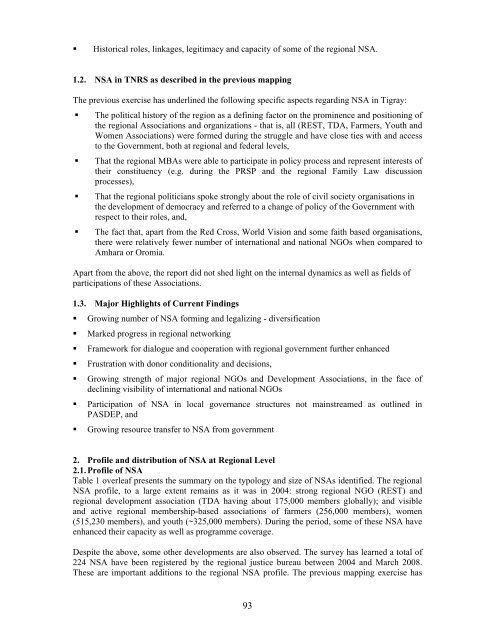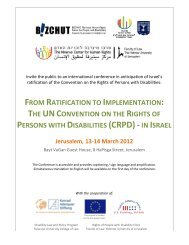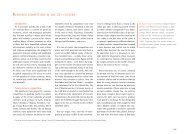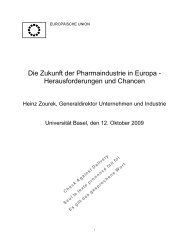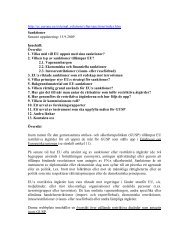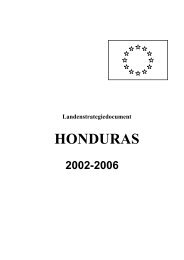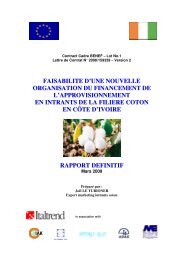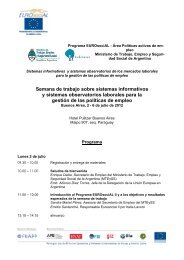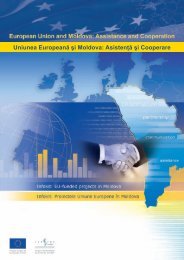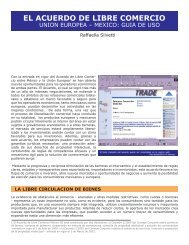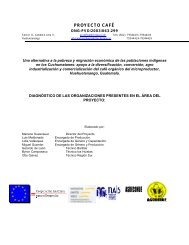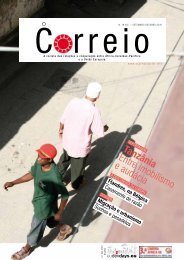Regional Reports - the European External Action Service
Regional Reports - the European External Action Service
Regional Reports - the European External Action Service
Create successful ePaper yourself
Turn your PDF publications into a flip-book with our unique Google optimized e-Paper software.
� Historical roles, linkages, legitimacy and capacity of some of <strong>the</strong> regional NSA.<br />
1.2. NSA in TNRS as described in <strong>the</strong> previous mapping<br />
The previous exercise has underlined <strong>the</strong> following specific aspects regarding NSA in Tigray:<br />
� The political history of <strong>the</strong> region as a defining factor on <strong>the</strong> prominence and positioning of<br />
<strong>the</strong> regional Associations and organizations - that is, all (REST, TDA, Farmers, Youth and<br />
Women Associations) were formed during <strong>the</strong> struggle and have close ties with and access<br />
to <strong>the</strong> Government, both at regional and federal levels,<br />
� That <strong>the</strong> regional MBAs were able to participate in policy process and represent interests of<br />
<strong>the</strong>ir constituency (e.g. during <strong>the</strong> PRSP and <strong>the</strong> regional Family Law discussion<br />
processes),<br />
� That <strong>the</strong> regional politicians spoke strongly about <strong>the</strong> role of civil society organisations in<br />
<strong>the</strong> development of democracy and referred to a change of policy of <strong>the</strong> Government with<br />
respect to <strong>the</strong>ir roles, and,<br />
� The fact that, apart from <strong>the</strong> Red Cross, World Vision and some faith based organisations,<br />
<strong>the</strong>re were relatively fewer number of international and national NGOs when compared to<br />
Amhara or Oromia.<br />
Apart from <strong>the</strong> above, <strong>the</strong> report did not shed light on <strong>the</strong> internal dynamics as well as fields of<br />
participations of <strong>the</strong>se Associations.<br />
1.3. Major Highlights of Current Findings<br />
� Growing number of NSA forming and legalizing - diversification<br />
� Marked progress in regional networking<br />
� Framework for dialogue and cooperation with regional government fur<strong>the</strong>r enhanced<br />
� Frustration with donor conditionality and decisions,<br />
� Growing strength of major regional NGOs and Development Associations, in <strong>the</strong> face of<br />
declining visibility of international and national NGOs<br />
� Participation of NSA in local governance structures not mainstreamed as outlined in<br />
PASDEP, and<br />
� Growing resource transfer to NSA from government<br />
2. Profile and distribution of NSA at <strong>Regional</strong> Level<br />
2.1. Profile of NSA<br />
Table 1 overleaf presents <strong>the</strong> summary on <strong>the</strong> typology and size of NSAs identified. The regional<br />
NSA profile, to a large extent remains as it was in 2004: strong regional NGO (REST) and<br />
regional development association (TDA having about 175,000 members globally); and visible<br />
and active regional membership-based associations of farmers (256,000 members), women<br />
(515,230 members), and youth (~325,000 members). During <strong>the</strong> period, some of <strong>the</strong>se NSA have<br />
enhanced <strong>the</strong>ir capacity as well as programme coverage.<br />
Despite <strong>the</strong> above, some o<strong>the</strong>r developments are also observed. The survey has learned a total of<br />
224 NSA have been registered by <strong>the</strong> regional justice bureau between 2004 and March 2008.<br />
These are important additions to <strong>the</strong> regional NSA profile. The previous mapping exercise has<br />
93


